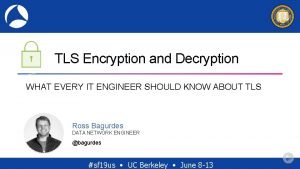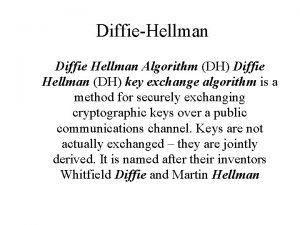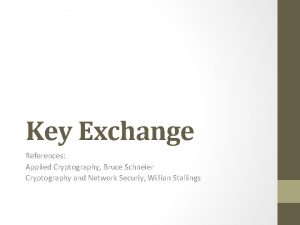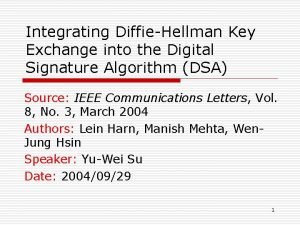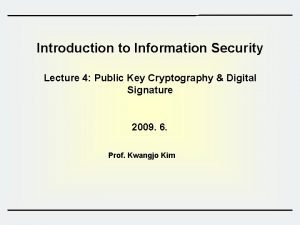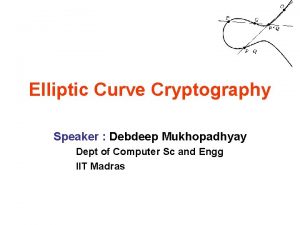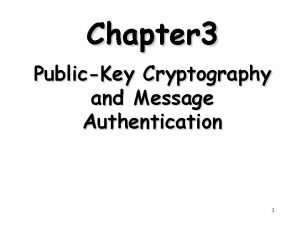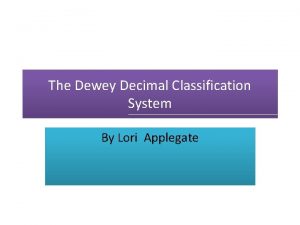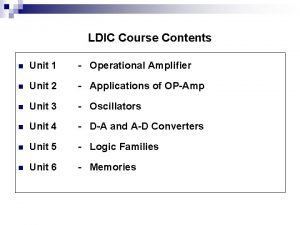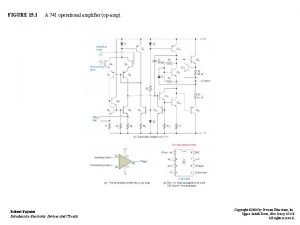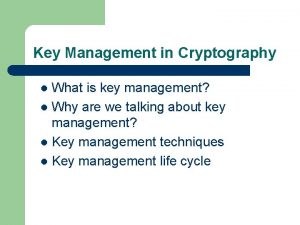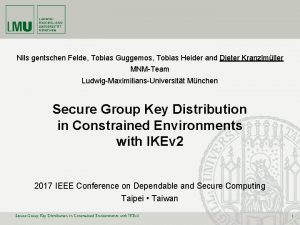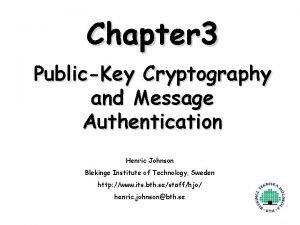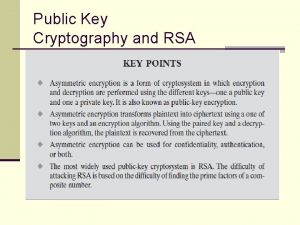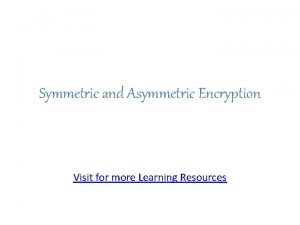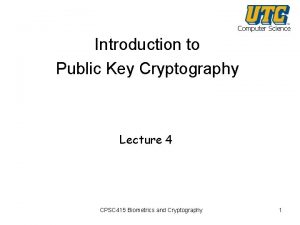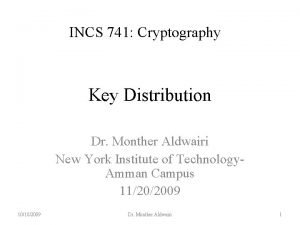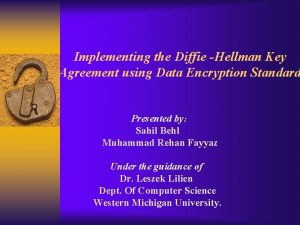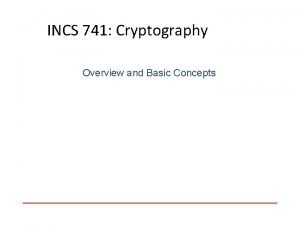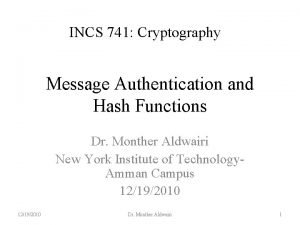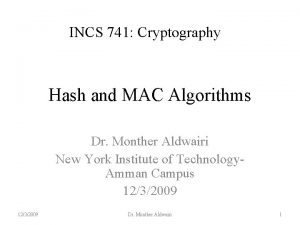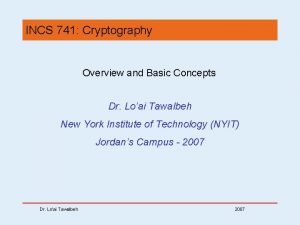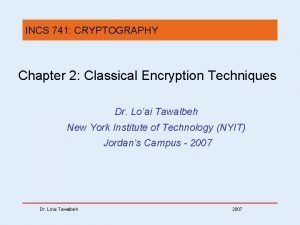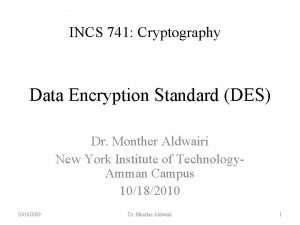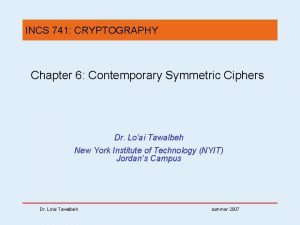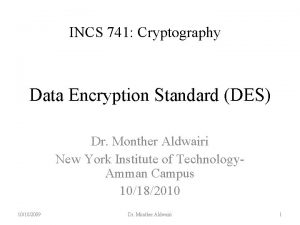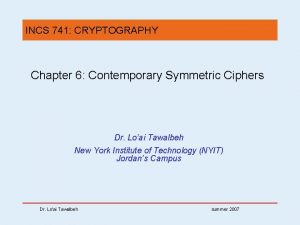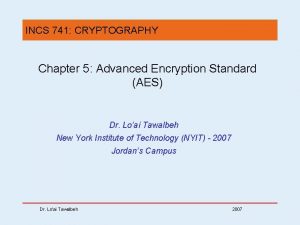INCS 741 Cryptography Key Management and Diffie Hellman


























- Slides: 26

INCS 741: Cryptography Key Management and Diffie. Hellman Dr. Monther Aldwairi New York Institute of Technology. Amman Campus 12/3/2009 Dr. Monther Aldwairi 1

Key Management • public-key encryption helps address key distribution problems • two aspects of this: – distribution of public keys – use of public-key encryption to distribute secret keys

Distribution of Public Keys • can be considered as using one of: – public announcement – publicly available directory – public-key authority – public-key certificates

Public Announcement • users distribute public keys to recipients or broadcast to community at large – eg. append PGP keys to email messages or post to news groups or email list • major weakness is forgery – anyone can create a key claiming to be someone else and broadcast it – until forgery is discovered can masquerade as claimed user

Publicly Available Directory • Registering keys with a public directory – directory must be trusted entity or organization – contains {name, public-key} entries – is periodically published and accessed electronically – participants register securely with directory – participants can replace key at any time • still vulnerable to tampering or forgery – adversary succeeds in obtaining the private key of the directory authority – could tamper with the records kept by the authority.

Public-Key Authority • improve security by tightening control over distribution of keys from directory • has properties of directory • and requires users to know public key for the directory • then users interact with directory to obtain any desired public key securely – does require real-time access to directory when keys are needed

Public-Key Authority

Public-Key Authority Drawbacks • The public-key authority could be somewhat of a bottleneck in the system • A user must appeal to the authority for a public key for every other user that it wishes to contact. • As before, the directory of names and public keys maintained by the authority is vulnerable to tampering. 11/8/2009 Dr. Monther Aldwairi 8

Public-Key Certificates • certificates allow key exchange without realtime access to public-key authority • a certificate binds identity to public key – usually with other info such as period of validity, rights of use etc • with all contents signed by a trusted Public. Key or Certificate Authority (CA) • can be verified by anyone who knows the public-key certificate authorities public-key

Requirements • Any participant determine the name and public key of the certificate's owner. • Any participant can verify that the certificate originated from the certificate authority. • Only the certificate authority can create and update certificates. • Any participant can verify the currency of the certificate. 11/8/2009 Dr. Monther Aldwairi 10

Public-Key Certificates

Public-Key Distribution of Secret Keys • • use previous methods to obtain public-key can use for secrecy or authentication but public-key algorithms are slow so usually want to use private-key encryption to protect message contents • hence need a session key • have several alternatives for negotiating a suitable session

Simple Secret Key Distribution • proposed by Merkle in 1979 – A generates a new temporary public key pair – A sends B the public key and their identity – B generates a session key K sends it to A encrypted using the supplied public key – A decrypts the session key and both use (discard keys) • problem is that an opponent can intercept and impersonate both halves of protocol – adversary who can intercept messages and then either relay the intercepted message or substitute another message

Man in the Middle Attack • A generates a public/private key pair {PUa, PRa} and transmits a message intended for B consisting of PUa and an identifier of A, IDA. • E intercepts the message, creates its own public/private key pair {PUe, PRe} and transmits PUe||IDA to B. • B generates a secret key, Ks, and transmits E(PUe, Ks). • E intercepts the message, and learns Ks by computing 11/8/2009 14 D(PRe, E(PUe, Ks)). Dr. Monther Aldwairi

Public-Key Distribution of Secret Keys • if have securely exchanged public-keys:

Hybrid Key Distribution • • retain use of private-key KDC shares secret master key with each user distributes session key using master key public-key used to distribute master keys – especially useful with widely distributed users • rationale – performance – backward compatibility

Diffie-Hellman Key Exchange • first public-key type scheme proposed • by Diffie & Hellman in 1976 along with the exposition of public key concepts – note: now know that Williamson (UK CESG) secretly proposed the concept in 1970 • is a practical method for public exchange of a secret key • used in a number of commercial products

Diffie-Hellman Key Exchange • a public-key distribution scheme – cannot be used to exchange an arbitrary message – rather it can establish a common key – known only to the two participants • value of key depends on the participants (and their private and public key information) • based on exponentiation in a finite (Galois) field (modulo a prime or a polynomial) - easy • security relies on the difficulty of computing discrete logarithms (similar to factoring) – hard

Discrete Logarithms • a primitive root of a prime number p as one whose powers modulo p generate all the integers from 1 to p-1 – For any integer b and a primitive root a of prime number p, we can find a unique exponent i such that – b ≡ ai (mod p) where 0 ≤ i ≤(p-1) • The exponent i is referred to as the discrete logarithm of b for the base a, mod p. – dloga, p (b)= i 11/8/2009 Dr. Monther Aldwairi 19

Diffie-Hellman Setup • all users agree on global parameters: – large prime integer or polynomial q – α being a primitive root mod q • each user (eg. A) generates their key – chooses a secret key (number): x. A < q x. A – compute their public key: y. A = α mod q • each user makes public that key y. A

Diffie-Hellman Key Exchange • shared session key for users A & B is KAB: x. A. x. B KAB = α mod q x. B = y. A mod q (which B can compute) x. A = y. B mod q (which A can compute) • KAB is used as session key in private-key encryption scheme between Alice and Bob • if Alice and Bob subsequently communicate, they will have the same key as before, unless they choose new public-keys • attacker needs an x, must solve discrete log

11/8/2009 Dr. Monther Aldwairi 22

Security of the Diffie-Hellman • An adversary only has the following ingredients to work with: q, α, YA, and YB. – XA and XB are private – Calculate discrete logarithm to determine the key – XB = dloga, q (YB) • The security of the Diffie-Hellman key exchange lies in the fact that, – it is relatively easy to calculate exponentials modulo a prime – it is very difficult to calculate discrete logarithms. For large primes, the latter task is considered infeasible. 11/8/2009 Dr. Monther Aldwairi 23

Diffie-Hellman Example • users Alice & Bob who wish to swap keys: • agree on prime q=353 and α=3 • select random secret keys: – A chooses x. A=97, B chooses x. B=233 • compute respective public keys: 97 – y. A=3 mod 353 = 40 (Alice) 233 – y. B=3 mod 353 = 248 (Bob) • compute shared session key as: x 97 – KAB= y. B A mod 353 = 248 = 160 x 233 – KAB= y. A B mod 353 = 40 = 160 (Alice) (Bob)

Attack Example • An attacker would have available the following information: – q = 353; α = 3; YA = 40; YB = 248 • By brute force, an attacker E can determine the common key by discovering a solution to eqns – 3 a mod 353 = 40 – 3 b mod 353 = 248 – calculate powers of 3 modulo 353, stopping when the result equals either 40 or 248 11/8/2009 Dr. Monther Aldwairi 25

Key Exchange Protocols 1. users could create random private/public D-H keys each time they communicate 2. users could create generate a long-lasting private value Xi (for user i) and calculate a public value Yi. – These public values and q and α, are stored in some central directory – user j can access i's public value, calculate KAB • both of these are vulnerable to a meet-in-the. Middle Attack – authentication of the keys is needed
 Diffie–hellman key exchange
Diffie–hellman key exchange Dh algorithm
Dh algorithm Diffie-hellman key exchange calculator
Diffie-hellman key exchange calculator Diffie hellman digital signature
Diffie hellman digital signature Diffie hellman color mixing
Diffie hellman color mixing Diffie hellman
Diffie hellman Elliptic curve diffie hellman example
Elliptic curve diffie hellman example Diffie-hellman
Diffie-hellman 741 dewey decimal
741 dewey decimal Operacijsko pojačalo
Operacijsko pojačalo 741 urban dictionary
741 urban dictionary Circuito diferenciador con lm 741 amplifier
Circuito diferenciador con lm 741 amplifier Piedinatura 741
Piedinatura 741 A 741
A 741 Differences between inverting and non inverting amplifier
Differences between inverting and non inverting amplifier Figure 15-1
Figure 15-1 Key management in cryptography
Key management in cryptography Kate hellman
Kate hellman Hellman
Hellman Kate hellman
Kate hellman Tobias hellman
Tobias hellman Mats hellman
Mats hellman Chan hellman
Chan hellman Public key cryptography and message authentication
Public key cryptography and message authentication Principles of public key cryptosystems
Principles of public key cryptosystems Advantages of asymmetric encryption
Advantages of asymmetric encryption Cryptography computer science
Cryptography computer science
